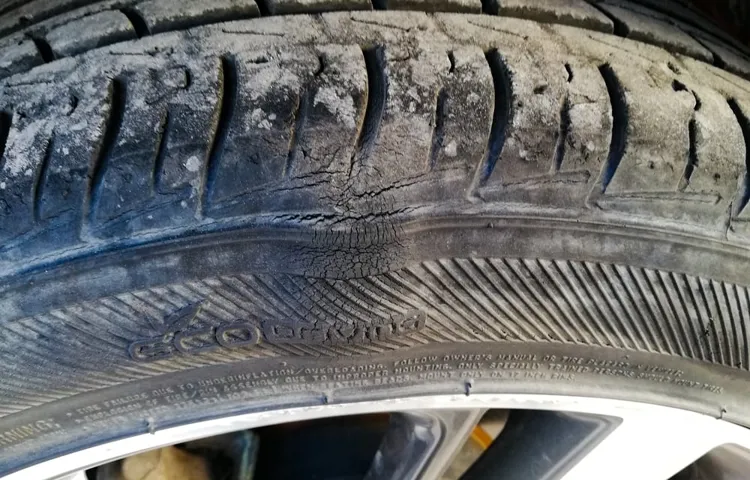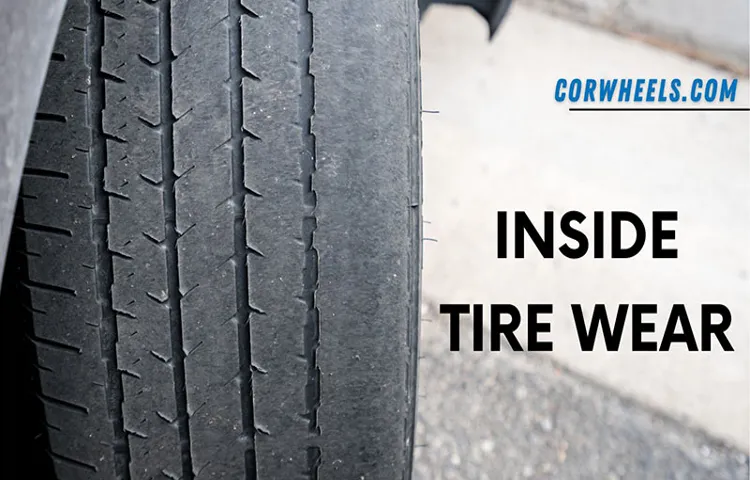Have you ever noticed that your tires wear unevenly? Specifically, have you noticed that the treads on the inside of your tires are wearing down faster than the treads on the outside? This common issue can lead to decreased traction, poor handling, and even affect your vehicle’s alignment. But what causes this uneven wear pattern? And how can you prevent it? In this blog post, we will delve into why your tires wear on the inside and what steps you can take to ensure that your tires have a longer and more even lifespan.
Wheel Alignment
If you notice that your tire is worn down on the inside, there is a high chance that your wheel alignment could be off. Wheel alignment refers to the angle and direction of your tires as they touch the road. When your tires are not correctly aligned, it can cause uneven tire wear, leading to a shorter tire lifespan and potentially dangerous driving conditions.
Several factors can cause wheel misalignment, including hitting potholes, car accidents, worn suspension parts, and improper installation of wheels or tires. It is essential to get your wheels aligned regularly to ensure your vehicle’s safety and optimize tire performance. Regular wheel alignment can save you money in the long run, as it protects your tires, increases gas mileage, and reduces wear and tear on other car components.
So if you notice any irregular tire wear, be sure to get your alignment checked to prevent any further damage.
Camber
Camber is an important aspect of wheel alignment that needs careful consideration. It refers to the angle of the wheels as viewed from the front of the vehicle. To put it simply, camber is the inward or outward tilt of the wheels from the vertical.
Proper camber ensures even tire wear and optimal vehicle handling. Too much positive camber, where the top of the wheel is tilted inward towards the vehicle, can make the vehicle unstable and cause steering problems. Conversely, too much negative camber, where the top of the wheel tilts away from the vehicle, can cause excessive wear on the outer edges of the tires.
Therefore, a proper camber adjustment is crucial to maximizing vehicle performance and tire life. If you notice uneven tire wear or steering difficulties, it may be time to check your wheel alignment, including the camber angle.

Toe
If your car’s toe angle is off, you may notice your tires wearing unevenly or your steering feeling off-center. Getting a wheel alignment can help correct this issue. During a wheel alignment, a technician will adjust the toe angle, as well as the camber and caster angles.
Toe angle refers to how much the front of the tires point in or out, and it can affect tire wear and steering. If your car has too much toe-in, the front edges of the tires will wear down faster than the rear edges. If it has too much toe-out, the opposite is true.
Having the correct toe angle can help your tires last longer and your car handle better. So if you notice any strange wear pattern on your tires or your steering feels off, it’s worth taking your car in for a wheel alignment.
Caster
Caster wheels play a crucial role in ensuring proper wheel alignment in your vehicle. Wheel alignment refers to the angle and direction at which your wheels point, affecting your vehicle’s steering, suspension, and tire performance. Caster, which is the angle of the steering axis when viewed from the side of the vehicle, adds stability and helps the wheels return to the straight-ahead position after turning.
If your caster angle is off, it can result in uneven tire wear, poor handling, and even a loss of control of your vehicle. Therefore, it’s important to have your caster checked regularly by a mechanic and adjusted if necessary to ensure proper alignment and a smooth ride. Don’t overlook the crucial role caster plays in keeping your vehicle running smoothly.
Suspension Issues
One of the common suspension issues that can lead to tire wear on the inside is improper wheel alignment. When your wheels are not aligned correctly, they can tilt inward or outward, causing the tire to wear on the inside edge. Worn suspension components such as the ball joints, shocks, and struts can also cause the tire wear on the inside as they can cause the wheels to move out of alignment.
Overinflated tires put more stress on the center of the tire, leading to wear on the inner edges. On the other hand, underinflated tires can cause the outer edges of the tire to wear out faster. So to avoid tire wear on the inside, you should ensure your wheels are aligned correctly, drive carefully on uneven roads, replace worn-out suspension components, and ensure your tires are correctly inflated.
Worn Shocks and Struts
If you are experiencing a bumpy ride or your car is swaying on turns, the problem could be worn shocks, struts, or suspension components. Worn shocks and struts have a negative impact on your vehicle’s handling and stability, making it difficult to control and increasing the risk of accidents. They can also cause uneven tire wear and premature failure of other suspension components.
Shocks and struts are essential for maintaining a smooth ride, providing adequate control and steering response, and ensuring consistent tire contact with the road. If you suspect that your vehicle’s shocks and struts are worn, it’s crucial to have them inspected by a qualified technician and replaced if necessary. Regular suspension maintenance can help prolong the lifespan of these components and keep your vehicle safe and comfortable.
Broken or Bent Components
When your suspension is damaged, it can seriously affect your vehicle’s ability to handle rough terrain or even just basic road conditions. Broken or bent components within your suspension system can cause a wide range of issues ranging from uneven tire wear to vehicle instability and rough rides. Your suspension has several critical components that work together to keep your vehicle away from the road and absorb any shocks from bumps and lumps in the pavement.
The springs, shocks, struts, and control arms all play important roles in your suspension system. Damage to any of these components can result in rough handling, noise, bouncing, and even vibration. If you suspect that your suspension system is not working as it should, do not hesitate to have it inspected by a professional mechanic who can diagnose the problem and determine the appropriate repairs.
By doing so, you can ensure the safety of your vehicle and yourself on the road.
Improper Tire Maintenance
Improper tire maintenance can cause your tires to wear unevenly and faster than expected, including on the inside of the tire. Factors like underinflation, overloading, and misalignment can all contribute to this issue. Driving on underinflated tires can cause the center of the tread to wear out faster, while overloading your vehicle can cause the tires to wear on the edges.
Additionally, misalignment can cause the wheels to point inward or outward, resulting in the tires wearing more on the inside or outside edges. Regularly checking tire pressure, avoiding overloading your vehicle, and getting your alignment checked can all help prevent uneven tire wear and extend the lifespan of your tires. By taking proper care of your tires, you’ll not only save money on replacement costs, but you’ll also ensure that your vehicle performs at its best and stays safe on the road.
Underinflation
Underinflation is a common issue among drivers that can potentially cause serious road accidents and damage to their vehicles. Improper tire maintenance is often the root cause of this problem. Many drivers forget to regularly check their tire pressure, leading to tires that are underinflated and in danger of bursting or losing traction on the road.
This can lead to longer stopping distances, which can be especially dangerous in emergency situations. It’s important to take the time to check your tire pressure regularly and make sure that your tires are properly inflated according to the manufacturer’s recommendations. While it may seem like a minor inconvenience, taking proper care of your tires can help to keep you safe on the road and save you from costly repairs or replacements in the long run.
Overinflation
Improper tire maintenance can lead to overinflation, a dangerous and oftentimes overlooked problem. Overinflated tires have an increased risk of blowing out while driving, which can cause accidents and damages. This issue is most common in hot weather conditions, as heat causes the air inside the tires to expand and pressure to increase.
Regularly checking tire pressure and adjusting it to the manufacturer’s recommended levels can prevent overinflation. Additionally, avoiding overloading or overusing tires beyond their recommended lifespan can also prevent this issue. Accidentally overinflating tires can happen to anyone, but it is crucial to be aware of the consequences and take preventative measures to ensure safe driving on the road.
Conclusion
So, as we come to the end of this tire-wearing journey, the inner truth behind the inner wear of your tires is revealed. It all boils down to alignment – just like in life, where being out of alignment can lead to some wonky outcomes. So, keep your wheels aligned, your driving in check, and you’ll be sure to have a smooth ride ahead.
“
FAQs
What are some common causes of tire wear on the inside?
Common causes of tire wear on the inside include misaligned wheels, worn out suspension components, low tire pressure, and aggressive driving.
How can I tell if my tires are wearing out unevenly on the inside?
Uneven tire wear can be identified by looking for worn tread patterns or by feeling for uneven bumps or dips on the tire surface. It is also important to regularly inspect your tires for signs of wear.
Can tire rotation prevent wear on the inside of my tires?
Yes, rotating your tires at regular intervals can help to evenly distribute the wear on your tires and prevent excessive wear on the inside of the tire.
What should I do if I notice uneven wear on the inside of my tires?
If you notice uneven wear on the inside of your tires, it is important to have your vehicle inspected by a professional mechanic who can identify and address the underlying cause of the problem.
Is it safe to continue driving on tires that are wearing on the inside?
Driving on tires that are wearing on the inside can be dangerous, as it can lead to reduced traction and stability on the road. It is important to address any tire wear issues promptly to ensure your safety on the road.
Can tire pressure affect wear on the inside of my tires?
Yes, low tire pressure can cause the inside of the tire to wear more quickly than the outside. It is important to regularly check your tire pressure to ensure that it is at the proper level.
How often should I have my vehicle’s alignment checked to prevent wear on the inside of my tires?
It is recommended that you have your vehicle’s alignment checked every 6,000 to 10,000 miles to help prevent excessive tire wear on the inside.

